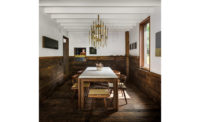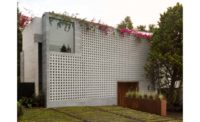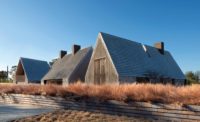Agahnia House by Sebastian Mariscal
La Jolla, California

The entrance on the street appears unassuming amid planting, which softens the clustered volumes clad in blue limestone.
Photo © Paúl Rivera

Light monitors pop up among the roof’s dense flora.
Photo © Paúl Rivera

While the house seems to be one level from the street, at the back, the drop in the slope allows a lower level for recreational spaces to be tucked under the living and dining areas, where expanses of glass and open decks make the most of the west-facing view to a golf course and the Pacific Ocean.
Photo © Paúl Rivera

While the house seems to be one level from the street, at the back, the drop in the slope allows a lower level for recreational spaces to be tucked under the living and dining areas, where expanses of glass and open decks make the most of the west-facing view to a golf course and the Pacific Ocean.
Photo © Paúl Rivera

A gridded wood screen separates the public areas from the interior courtyard, which affords privacy to the guest bedroom behind it.
Photo © Paúl Rivera

The living and dining areas open onto a wood deck. Sliding glass doors under an elongated steel beam create a column-free space 50 feet long.
Photo © Paúl Rivera

At the north end of the deck is the master bedroom.
Photo © Paúl Rivera

Image courtesy Sebastian Mariscal Studio

Image courtesy Sebastian Mariscal Studio









Architects & Firms
“I wanted the architecture to be taken over by lush planting,” says Sebastian Mariscal (a Design Vanguard winner, RECORD, December 2007) about the 7,400-square-foot house he designed in the hills of La Jolla, California. The location is a good choice for such botanical immersion. The picturesque town, near San Diego, edges the Pacific Ocean with bluffs and sandy beaches and is known for its sunny weather, not to mention the abundance of palm and eucalyptus trees.
Additional Content:
Jump to credits & specifications
The effulgent vegetation enveloping this site owes much to Marcie Harris Landscape, a firm that consulted with Mariscal on several projects during his 13 years in San Diego before he moved his practice to Boston in 2012. The greenery lustily invades an assemblage of rectangular and square connected blue limestone–clad volumes stretched along the ridge of the half-acre property. At his Phoenix House nearby, Mariscal had draped the exterior concrete board-form walls with vines (a 2014 Record House); in this case, the planting is even more prevalent, with jasmine pandorea cascading from the roof gardens, softening the gray-white stone walls. The fragrance emanating from these hanging plants makes you appreciate another aesthetic dimension.
The front of the house hugs the street with an abundance of Brisbane box and Silversheen pittosporum, so you have to look carefully to spot the “humble” entrance, as Mariscal calls it. “Too many houses here are designed for curb appeal,” he says about La Jolla’s fanciful polyglot of residential styles. “But we didn’t want that.” Not surprisingly, Mariscal’s designs evoke the solidity of materials and massing, alternating with voids, of Louis Kahn’s Salk Institute several miles away, and even the stuccoed white planes of Irving Gill’s architecture in downtown La Jolla.
While the house appears to be one-story high from the front, that perception shifts at the back, where the main level is expressed as a strong rectilinear bar, extending along the west elevation and edged by an expansive mahogany-and-cable balustrade. Another floor is tucked below it where the slope drops, with the entirety looking out on a verdant golf course—“a lawn we don’t have to mow,” says owner Kayvon Agahnia. Beyond it are views of the Pacific.
The house sits high enough on the steep slope to command this vista, but other houses are perched even higher along the street’s vertiginous ascent. “That is why I wanted to create a fifth facade,” says Mariscal about the thickly overgrown roof gardens and terraces. “This is for the neighbors looking down from above.”
The slightly meandering entry sequence brings you through a gate into an open court, where a mahogany gangplank bridges a koi pond to the vestibule and a small internal courtyard planted with slender China Doll trees. But this is only the setup for what is to come: just ahead, the living and dining area rises dramatically upward to a 15-foot-high mahogany ceiling and expands out to the drop-dead view of the golf course and the ocean to the west. Here a 50-foot-wide expanse of glass sliding walls is free of columns, owing to a steel beam spanning the length of the space in this hybrid wood-frame, cast-in-place concrete, and steel structure. The living and dining area, demarcated by meticulously detailed mahogany cabinetry and backed by a gridded wood screen, is behind you as the glass walls to the outdoor deck of Mangaris wood slide away, blurring any distinction between inside and out.
“We often gather here, especially at sunset,” says Kayvon, who, along with his wife, Maite, was so enraptured by the natural panorama, they located their bedroom at the northern end of the deck. Bedrooms for the two children, now almost grown, occupy this wing as well, where the spaces are treated as clustered units, to break down the scale of the large residence. Two light monitors push up above the flat roof planes like periscopes to bring daylight into an internal corridor. Near the two monitors is a suite, facing east, with its own small patio, for Kayvon’s mother. Originally, it was reserved for the children as a playroom. “The design can evolve as the family evolves,” says Mariscal. A distinct but connected pavilion on the northwest corner is reserved as an art studio for Maite, an abstract painter and photographer. The 17-foot-high cubiform space also accommodates her office on a mezzanine.
Outdoor steps from the studio lead down the west side to the floor tucked under the main level and bolstered by concrete retaining walls and caissons. Most of this floor is devoted to casual recreation space. “Our kids love to entertain here,” says Maite, “and I can have receptions for those coming to see my art.” In a gym on the south end, Kayvon, a triathlete, can work out. Despite having a narrower deck than the floor above, both spaces still partake of the ultimate in relaxation—the rolling landscape (with a few golf carts).
On top of the residence are roof gardens, one with a wood deck and beach sand. While the weight of the soil for growing white yarrow and dwarf mat rush and other foliage required beefing up the wood joists, the payoff is greater than the combined visual and olfactory sensations. The gardens not only insulate the interior from the sun’s heat but absorb most of the rainwater runoff. In addition, photovoltaic panels on the studio and garage roofs provide 95 percent of the house’s electricity, adding to the sustainability efforts, along with natural ventilation, which the family often uses in lieu of air-conditioning.
Kayvon is not only a client. He is also an investment partner in Mariscal’s practice for various development and design projects the studio is executing in Boston and Mexico (where the Mexican-born designer keeps a second office). Maite, who initially wasn’t sold on the idea of sandblasted concrete floors in the living/dining room, says, “I went along. I have a blind trust in Sebastian. He’s never arrogant, and he’s always calm, a therapist as well as architect.” Kayvon is also effusive about how the house turned out. “I wake up loving the house,” says Kayvon, “and I go to sleep loving the house.” Maite adds, “It is modern, organic, and timeless.” Mariscal gives credit for its success to the power of plants: “Luxuriant vegetation is always going to make architecture better,” he says. He has a point, but there are other elements that help considerably, such as his play of masses and voids and use of materials. And, of course, the view.
CreditsArchitect: Sebastian Mariscal Studio — Sebastian Mariscal, principal; Mauricio de la
Engineer: DCI Engineers (structural)
Consultants: Marcie Harris Landscape Architecture (landscape)
General contractor: RLP Development |
SpecificationsBlue limestone Gem International
Wood frame sliding doors Mix Legno Group
Chandeliers Ligne Roset
PV system Alternative Energy Application |
Editor's Note, April 2, 2019: This story has been updated to remove a reference to the project budget.














